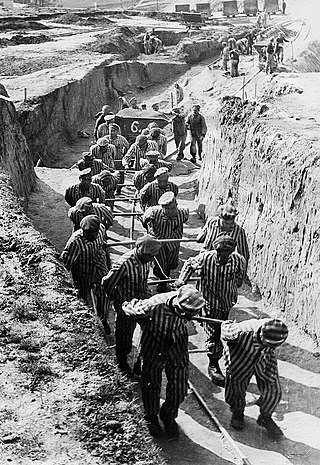
Messerschmitt AG was a German share-ownership limited, aircraft manufacturing corporation named after its chief designer Willy Messerschmitt from mid-July 1938 onwards, and known primarily for its World War II fighter aircraft, in particular the Bf 109 and Me 262. The company survived in the post-war era, undergoing a number of mergers and changing its name from Messerschmitt to Messerschmitt-Bölkow-Blohm before being bought by Deutsche Aerospace in 1989.

Mauthausen was a concentration camp that first appeared in 1918, and the original Mauthausen camp was not situated precisely on the same spot as the latter more commonly known Mauthausen opened 20 years later. The latter Mauthausen was situated on a hill above the market town of Mauthausen, Upper Austria. It was the main camp of a group with nearly 100 further subcamps located throughout Austria and southern Germany. The three Gusen concentration camps in and around the village of St Georgen/Gusen, just a few kilometres from Mauthausen, held a significant proportion of prisoners within the camp complex, at times exceeding the number of prisoners at the Mauthausen main camp.

German Earth and Stone Works was an SS-owned company created to procure and manufacture building materials for state construction projects in Nazi Germany. DEST was a subsidiary company of Amtsgruppe W of SS Main Economic and Administrative Office (WVHA). Both Amt. W and the WVHA were headed by Waffen-SS generals Oswald Pohl and Georg Lörner.

The Dachau trials, also known as the Dachau Military Tribunal, handled the prosecution of almost every war criminal captured in the U.S. military zones in Allied-occupied Germany and in Allied-occupied Austria, and the prosecutions of military personnel and civilian persons who committed war crimes against the American military and American citizens. The war-crime trials were held within the compound of the former Dachau concentration camp by military tribunals authorized by the Judge Advocate General of the U.S. Third Army.

Raxwerke or Rax-Werke was a facility of the Wiener Neustädter Lokomotivfabrik at Wiener Neustadt in Lower Austria. During World War II, the company also produced lamps for Panzer tanks and anti-aircraft guns. Two Raxwerke plants employed several thousand forced laborers from the Mauthausen-Gusen concentration camp.

Sankt Georgen an der Gusen is a small market town in Upper Austria, Austria, between the municipalities of Luftenberg and Langenstein. As of 2015, the town had 3,779 inhabitants.
The Mauthausen-Gusen camp trials were a set of trials of SS concentration camp personnel following World War II, heard by an American military government court at Dachau. Between March 29 and May 13, 1946, and then from August 6 to August 21, 1947, a total of 69 former camp personnel were tried. Among them were some of the former guards at the Mauthausen-Gusen concentration camp system and August Eigruber, a former Gauleiter of Upper Austria.

Père (Father) Jacques de Jésus, OCD, was a French Roman Catholic priest and Discalced Carmelite friar. While serving as headmaster of a boarding school run by his order, he took in several Jewish refugees to protect them from the Nazi government of occupation, for which he was arrested and imprisoned in various concentration camps.
The Steyr-Münichholz concentration camp was one in a number of subcamps of the Mauthausen-Gusen concentration camp in Upper Austria. Inmates were drawn from the main camp, in order to exploit their labor for producing arms in Steyr-Daimler-Puch corporation factories, and to build air-raid bunkers in the town of Steyr.

The Redl-Zipf V-2 rocket facility located in central Austria between Vöcklabruck and Vöcklamarkt and established in September 1943 began operation for V-2 rocket motor testing after Raxwerke test equipment had been moved from Friedrichshafen.
Rudolf Anton Haunschmied is an Austrian author and local historian.

Friedrich Karl Hermann Entress was a German camp doctor in various concentration and extermination camps during the Second World War. He conducted human medical experimentation at Auschwitz and introduced the procedure there of injecting lethal doses of phenol directly into the hearts of prisoners. He was captured by the Allies in 1945, sentenced to death at the Mauthausen-Gusen camp trials, and executed in 1947.
Albert Sauer was a German commandant of Mauthausen-Gusen concentration camp.

Granitwerke Mauthausen was one of the names used by the DEST company for its branch based in Sankt Georgen an der Gusen and which exploited the slave manpower confined in certain subcamps of the Mauthausen-Gusen concentration camp system: Gusen I, Gusen II, Gusen III, and Mauthausen.

The Jägerstab was a Nazi German governmental task force whose aim was to increase production of fighter aircraft during World War II. Established in March 1944, it was composed of government and SS personnel, as well as representatives of the aircraft manufacturers. The task force played a key role in the Emergency Fighter Program, including the "people's fighter" Heinkel He 162.

Gusen was a subcamp of Mauthausen concentration camp operated by the SS between the villages of Sankt Georgen an der Gusen and Langestein in the Reichsgau Ostmark. Primarily populated by Polish prisoners, there were also large numbers of Spanish Republicans, Soviet citizens, and Italians. Initially, prisoners worked in nearby quarries, producing granite which was sold by the SS company DEST.

Forced labor was an important and ubiquitous aspect of the Nazi concentration camps which operated in Nazi Germany and German-occupied Europe between 1933 and 1945. It was the harshest and most inhumane part of a larger system of forced labor in Nazi Germany.
This page is based on this
Wikipedia article Text is available under the
CC BY-SA 4.0 license; additional terms may apply.
Images, videos and audio are available under their respective licenses.














